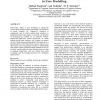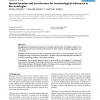536 search results - page 39 / 108 » Computing Spatial Similarity by Games |
BMCBI
2010
13 years 11 months ago
2010
Background: Microarray measurements are susceptible to a variety of experimental artifacts, some of which give rise to systematic biases that are spatially dependent in a unique w...
IUI
1997
ACM
14 years 3 months ago
1997
ACM
Historically, efforts at user modelling in educational systems have tended to employ knowledge representations in which symbolic (or "linguistic") cognition is emphasize...
BMCBI
2007
13 years 11 months ago
2007
Background: An adequate and expressive ontological representation of biological organisms and their parts requires formal reasoning mechanisms for their relations of physical aggr...
SPEECH
2002
13 years 10 months ago
2002
This paper1 discusses the use of `conversational' or `dialogue games' as a basis for building dialogue systems. We give a tutorial overview of some recent attempts to re...
CAP
2010
13 years 6 months ago
2010
Binary Decision Diagrams (BDDs) are widely used in formal verification. They are also widely known for consuming large amounts of memory. For larger problems, a BDD computation wi...


